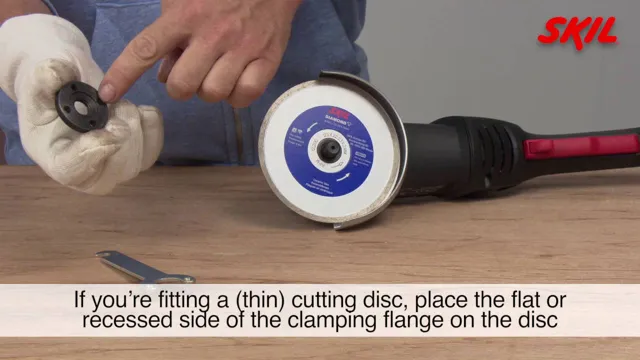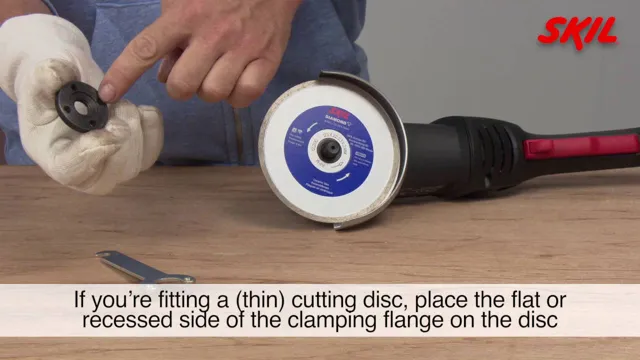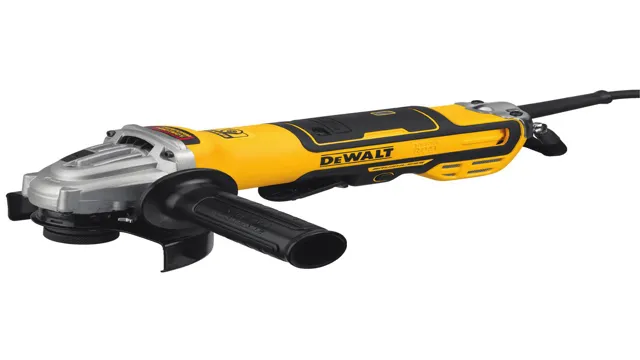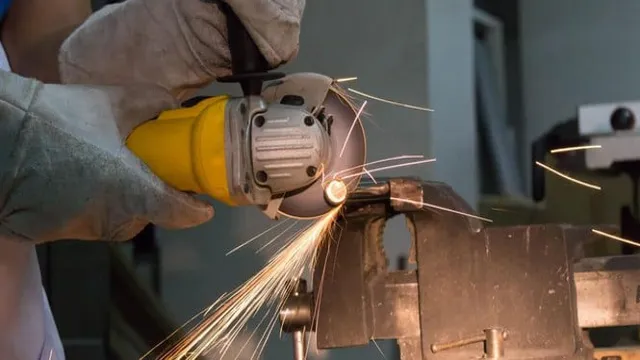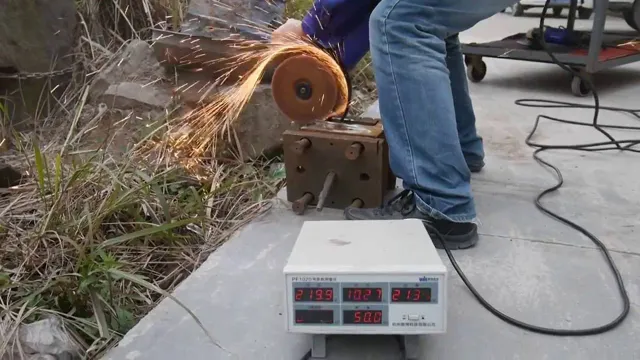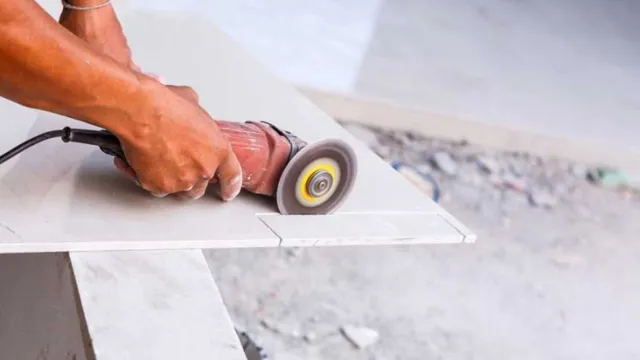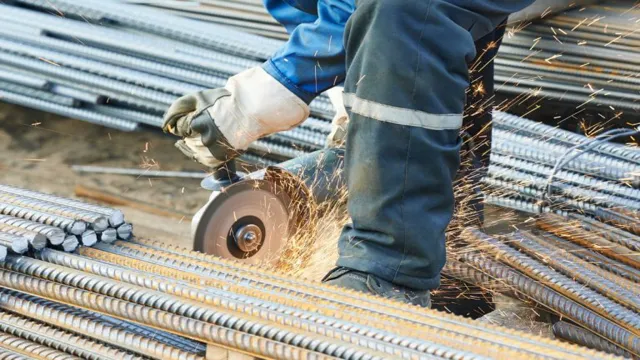Can You Use an Angle Grinder to Cut Metal? Expert Tips and Safety Precautions!

Cutting metal can be a challenging task, especially when it comes to dealing with thick metal pieces. However, using an angle grinder can make this task much easier for you. An angle grinder is a versatile tool that can be used for various tasks like sanding, cutting, and grinding.
It is one of the most commonly used power tools in metalworking. If you are not familiar with using an angle grinder to cut metal, don’t worry. In this blog post, we will discuss everything you need to know to confidently use an angle grinder for cutting metal like a pro.
So, let’s dive in!
What is an Angle Grinder?
Yes, an angle grinder is an incredibly powerful tool that can be used for a variety of purposes, including cutting metal. It contains a small, geared motor that rotates a disc or wheel at a high speed, allowing it to slice through even the toughest materials. However, it is important to note that using an angle grinder to cut metal can be dangerous if proper safety precautions are not taken.
To ensure that you stay safe while using an angle grinder, be sure to wear appropriate protective gear, such as gloves, goggles, and a mask, and make sure the workpiece is securely clamped down before you begin. Additionally, be sure to use the right disc or wheel for the job and to keep the tool moving smoothly and steadily to avoid overheating or damaging the disc. With these precautions in mind, an angle grinder can be a valuable tool for any metalworking project.
Definition and Functionality
An angle grinder is a versatile power tool that is used for grinding, cutting, and polishing various surfaces and materials. It comprises a motor-driven disc that rotates rapidly to perform its functions. The disc or wheel can be equipped with different types of attachments to perform various tasks.
For instance, a metal grinding wheel is used for grinding and smoothing uneven or rough metal surfaces, while a diamond cutting disc is used for cutting through dense materials like concrete. Angle grinders come in different sizes, ranging from small handheld models to large industrial-sized tools. They are commonly used in construction, metalworking, and woodworking.
One of the advantages of an angle grinder is that it can perform a wide range of tasks, making it a versatile tool to have in your workshop. However, the tool can also be dangerous when not handled properly, and it is important to follow safety precautions when using it. Overall, an angle grinder is a valuable tool for anyone who needs to perform various grinding, cutting, or polishing tasks efficiently and effectively.

Types of Angle Grinders
An angle grinder is a versatile power tool that is commonly used in metalworking, construction, and woodworking. It is equipped with a motor that rotates a disc at a high speed, allowing it to grind, cut, and polish a variety of materials. There are several types of angle grinders available on the market, each designed for specific applications.
The most common type is the handheld angle grinder, which is suitable for general-purpose grinding and cutting tasks. Another type is the benchtop grinder, which is larger and more powerful, and is used for heavy-duty tasks such as sharpening tools and shaping metal. A third type is the pneumatic grinder, which is powered by compressed air and is ideal for use in high-precision applications.
Finally, there are specialty angle grinders such as the concrete grinder, which is designed specifically for grinding and polishing concrete surfaces. Overall, the type of angle grinder that is best for your needs will depend on the materials you will be working with and the specific tasks you need to accomplish.
Benefits of Using an Angle Grinder to Cut Metal
Yes, absolutely! An angle grinder is the perfect tool to cut metal as it can effortlessly slice through even the toughest of materials. Whether it is for DIY projects or professional use, an angle grinder is an indispensable tool to have in your arsenal. Cutting metal requires precision, control, and speed, and an angle grinder delivers all of these effortlessly.
It is versatile, reliable, and can cut through a range of thicknesses with ease. Plus, it is compact and portable, so you can take it with you to various job sites. Using an angle grinder to cut metal is not only effective but also efficient.
It saves you time and effort, allowing you to finish your projects quickly and easily. With its powerful and fast-spinning blade, an angle grinder is the perfect tool to cut through metal sheets, bars, and pipes with ease. So why struggle with other tools when you can simply use an angle grinder to get the job done quickly and efficiently!
Versatility and Portability
When it comes to cutting metal, versatility and portability are essential factors in choosing the right tool for the job. That’s why an angle grinder is a popular choice for both professional metalworkers and DIY enthusiasts. With its compact size and lightweight design, an angle grinder can easily fit into tight spaces and be carried with you wherever you go.
Additionally, an angle grinder can handle a range of cutting tasks, from removing rust and burrs to cutting through thick metal sheets. This level of versatility makes an angle grinder an indispensable tool in any metalworking shop or garage. So if you’re looking to cut metal efficiently and effectively, consider investing in an angle grinder – it’s a versatile and portable tool that won’t disappoint.
Efficiency and Precision
If you’re looking for an efficient and precise way to cut metal, an angle grinder is the tool for you. One of the biggest benefits of using an angle grinder is the speed it offers. It can cut through metal quickly and easily, making it a great choice for any DIY project or professional job.
Additionally, its precision is unmatched. You can easily make precise cuts, even in hard-to-reach areas, with the right blade and technique. The angle grinder’s versatility is another major advantage.
It can be used to grind, sand, and even polish metal, making it a valuable addition to any workshop. Overall, using an angle grinder to cut metal can save time, increase accuracy, and up your DIY game. So, if you’re looking to take your metalworking skills to the next level, consider investing in an angle grinder.
Safety Precautions
Yes, an angle grinder can be used to cut metal, but it is important to take safety precautions to avoid any accidents or injuries. Always wear protective gear, such as safety goggles, gloves, and a face mask, to prevent any metal shavings or debris from flying into your eyes or mouth. Additionally, make sure to secure the metal piece firmly in place with clamps or vices to prevent it from moving or slipping during the cutting process.
It is also recommended to work in a well-ventilated area to avoid inhaling any fumes from the metal being cut. Remember to always follow the manufacturer’s instructions and guidelines when using an angle grinder, and use the appropriate cutting disc for the specific metal you are working with. By following these safety precautions, using an angle grinder to cut metal can be a useful and effective tool for various DIY and professional projects.
Wear Protective Gear
When it comes to any activity that poses a risk, always prioritize safety. Whether you’re riding a bike, skiing down a mountain, or playing contact sports, wearing protective gear is crucial. Helmets, knee pads, wrist guards, and other equipment can mean the difference between walking away from an accident unscathed or suffering a serious injury.
But protective gear isn’t just for extreme sports. Even leisurely activities like gardening or home repairs can be dangerous without proper protective gear. Wearing gloves, goggles, and sturdy shoes can prevent cuts, scrapes, and more serious injuries.
So, before you embark on any activity, ask yourself, “What kind of protective gear do I need?” And remember, it’s always better to be safe than sorry.
Secure the Metal Before Cutting
When it comes to working with metal, safety should always be a top priority. One of the most important safety precautions you can take is to secure the metal before cutting. This is especially important if you will be using power tools or other cutting equipment.
If the metal is not properly secured, it can move or shift during cutting, causing the blade or saw to kick back or slip. This can result in serious injury. To secure the metal, you can use clamps or a vise to hold it in place.
Make sure the metal is firmly secured and will not move or shift during cutting. You should also wear appropriate safety gear, such as eye and ear protection, gloves, and a dust mask. Keep the cutting area clear of debris and other obstacles, and make sure you have enough space to move around comfortably.
In addition to securing the metal before cutting, it is also important to use the right cutting tools and techniques. Choose the right type of saw or blade for the job, and make sure it is sharp and in good condition. Use slow, steady movements when cutting, and avoid forcing the blade or saw.
If the blade starts to bind or stall, stop the machine immediately and check for any problems. By following these safety precautions, you can minimize the risk of injury when working with metal. Remember that safety is always the most important consideration, and never take shortcuts or risks when it comes to your own well-being.
How to Cut Metal with an Angle Grinder
Yes, you can definitely use an angle grinder to cut metal! Angle grinders are incredibly versatile power tools that can handle a wide range of tasks, including cutting through metal pipes, rods, and sheet metal. However, before you get started, there are a few things you should keep in mind. First and foremost, safety should always be your top priority when working with power tools.
Make sure you wear proper protective gear, including eye and ear protection, a dust mask, and gloves. Also, be sure to choose the right type of cutting wheel for the job. Diamond blades are great for cutting through hard metals like steel, while abrasive blades work well on softer materials like aluminum.
And remember, always let the tool do the work and take your time to ensure clean and accurate cuts. With the right technique and safety precautions, an angle grinder can be a great tool for cutting through metal quickly and cleanly.
Prepare the Metal and Grinder
Cutting metal with an angle grinder can be a tricky task that requires careful preparation. First, you need to make sure that your grinder is equipped with an appropriate metal-cutting blade. Next, you should clamp the metal securely to a stable work surface to prevent it from moving around while you’re cutting.
Once you’ve secured the metal, you’re ready to start the cutting process. Keep in mind that this can produce a lot of sparks, so it’s important to wear protective gear like goggles and gloves. It’s also a good idea to keep a fire extinguisher nearby just in case.
With the metal prepared and the grinder ready to go, you’re now able to start cutting. Move the grinder in a controlled motion along the line that you want to cut, applying gentle pressure as needed. Remember to keep your hands steady and avoid making sudden movements that could cause the grinder to slip.
By following these steps, you can cut metal with an angle grinder effectively and safely.
Cutting Technique
Cutting metal is not as easy as it may seem, but with the right technique and tools, it can be done smoothly and accurately. One of the most common tools used for cutting metal is an angle grinder, which is a handheld power tool equipped with an abrasive cutting disc. To use an angle grinder, start by securing the metal piece you want to cut in place, then put on your safety gear, including eye protection and gloves.
Next, switch on the angle grinder and approach the metal piece, making sure to hold the tool firmly and keep it at the correct angle. Move the cutting disc slowly through the metal, applying gentle pressure, and avoid pushing too hard, as this can cause the blade to overheat or become damaged. Additionally, it is important to take frequent breaks to cool the metal and cutting disc, to ensure a smooth and even cut.
With practice, cutting metal using an angle grinder becomes easier and more efficient, providing precise results for any project. So, go ahead and give it a try!
Conclusion
In conclusion, the answer to the question of whether or not you can use an angle grinder to cut metal is a resounding yes! As long as you take the appropriate safety measures and use the proper attachments, an angle grinder can be a versatile and effective tool for all your metal-cutting needs. So go ahead and embrace your inner metalworking superhero, and let your trusty angle grinder be your sidekick in all your cutting adventures!”
FAQs
What is an angle grinder and how does it work?
An angle grinder is a handheld power tool that rotates a disc to grind or cut through various materials, including metal. It works by using a motor to spin the disc at high speeds to generate the necessary force for the task at hand.
What type of disc should I use for cutting metal with an angle grinder?
To cut metal with an angle grinder, you should use a cutting wheel or a diamond blade. A cutting wheel is better for thinner metal, while a diamond blade is suitable for thicker metal.
Can I use water to cool down the metal while cutting with an angle grinder?
No, you should never use water or any other liquid to cool down the metal while cutting with an angle grinder, as it can cause the disc to shatter and result in injury. Instead, make sure the disc is in good condition and use a light touch to avoid overheating the disc.
What safety precautions should I take while using an angle grinder to cut metal?
Wear appropriate personal protective equipment, such as goggles, gloves, and a dust mask, to protect yourself from metal particles and flying sparks. Always make sure the disc is in good condition and securely attached before use. Use two hands to operate the grinder and be mindful of the direction of sparks.
Can an angle grinder cut through thick metal?
Yes, an angle grinder can cut through thick metal, but it will require a powerful motor and a suitable cutting disc, such as a diamond blade. Make sure to use the appropriate cutting technique and be patient, as cutting through thick metal may take longer than cutting through thinner metal.
How do I change the cutting disc on an angle grinder?
To change the cutting disc on an angle grinder, first, make sure the tool is unplugged and the current disc is cool. Then, remove the locking nut and the old disc from the spindle, replace it with the new disc, and tighten the locking nut securely.
How should I dispose of used cutting discs from my angle grinder?
Used cutting discs should be disposed of properly to prevent injury. Allow the disc to cool down completely before throwing it away in a sturdy trash container or take it to a metal recycling facility. Do not throw the disc in the regular trash or attempt to recycle it with other household materials.

